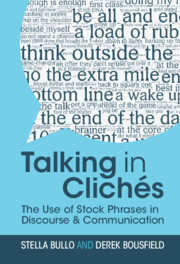Book contents
- Talking in Clichés
- Talking in Clichés
- Copyright page
- Contents
- Figures
- Tables
- Acknowledgements
- Abbreviations
- Chapter One On Clichés
- Chapter Two Clichés in Discourse
- Chapter Three Clichés as Argumentative Strategies
- Chapter Four Clichés as Social Cognition
- Chapter Five Clichés as Politeness Strategies in Evaluation
- Chapter Six Clichés as Identity Markers
- Chapter Seven Concluding Remarks
- Appendix 1: Clichés in News Comments
- Appendix 2: Clichés in Corporate Mission Statements
- Appendix 3: Clichés in Evaluation
- Appendix 4: Clichés as Identity Markers in BBC’s Reality TV Show, The Apprentice
- References
- Index
- References
References
Published online by Cambridge University Press: 27 October 2022
- Talking in Clichés
- Talking in Clichés
- Copyright page
- Contents
- Figures
- Tables
- Acknowledgements
- Abbreviations
- Chapter One On Clichés
- Chapter Two Clichés in Discourse
- Chapter Three Clichés as Argumentative Strategies
- Chapter Four Clichés as Social Cognition
- Chapter Five Clichés as Politeness Strategies in Evaluation
- Chapter Six Clichés as Identity Markers
- Chapter Seven Concluding Remarks
- Appendix 1: Clichés in News Comments
- Appendix 2: Clichés in Corporate Mission Statements
- Appendix 3: Clichés in Evaluation
- Appendix 4: Clichés as Identity Markers in BBC’s Reality TV Show, The Apprentice
- References
- Index
- References
Summary

- Type
- Chapter
- Information
- Talking in ClichésThe Use of Stock Phrases in Discourse and Communication, pp. 178 - 191Publisher: Cambridge University PressPrint publication year: 2022

